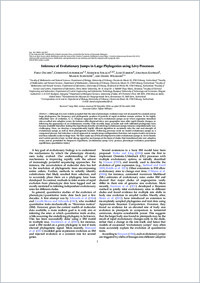Inference of evolutionary jumps in large phylogenies using Lévy processes
- Duchen, Pablo Department of Biology, University of Fribourg, Switzerland
- Leuenberger, Christoph Department of Biology, University of Fribourg, Switzerland - Department of Mathematics, University of Fribourg, Switzerland
- Szilágyi, Sándor M. Department of Informatics, University of Fribourg, Switzerland - Faculty of Sciences and Letters, Department of Informatics, Petru Maior University, Tîrgu Mures, Romania - Faculty of Electrical Engineering and Informatics, Department of Control Engineering and Information Technology, Budapest, Hungary
- Harmon, Luke Department of Biological Sciences, University of Idaho, Moscow-Idaho, United States
- Eastman, Jonathan Department of Biological Sciences, University of Idaho, Moscow-Idaho, United States
- Schweizer, Manuel Naturhistorisches Museum der Burgergemeinde Bern, Switzerland
- Wegmann, Daniel Department of Biology, University of Fribourg, Switzerland
-
27.03.2017
Published in:
- Systematic Biology. - 2017, vol. 66, no. 6, p. 950-963
English
Although it is now widely accepted that the rate of phenotypic evolution may not necessarily be constant across large phylogenies, the frequency and phylogenetic position of periods of rapid evolution remain unclear. In his highly influential view of evolution, G. G. Simpson supposed that such evolutionary jumps occur when organisms transition into so-called new adaptive zones, for instance after dispersal into a new geographic area, after rapid climatic changes, or following the appearance of an evolutionary novelty. Only recently, large, accurate and well calibrated phylogenies have become available that allow testing this hypothesis directly, yet inferring evolutionary jumps remains computationally very challenging. Here, we develop a computationally highly efficient algorithm to accurately infer the rate and strength of evolutionary jumps as well as their phylogenetic location. Following previous work we model evolutionary jumps as a compound process, but introduce a novel approach to sample jump configurations that does not require matrix inversions and thus naturally scales to large trees. We then make use of this development to infer evolutionary jumps in Anolis lizards and Loriinii parrots where we find strong signal for such jumps at the basis of clades that transitioned into new adaptive zones, just as postulated by Simpson’s hypothesis.
- Faculty
- Faculté des sciences et de médecine
- Department
- Département de Biologie
- Language
-
- English
- Classification
- Biological sciences
- License
-
License undefined
- Identifiers
-
- RERO DOC 305044
- DOI 10.1093/sysbio/syx028
- Persistent URL
- https://folia.unifr.ch/unifr/documents/305937
Statistics
Document views: 103
File downloads:
- pdf: 163
